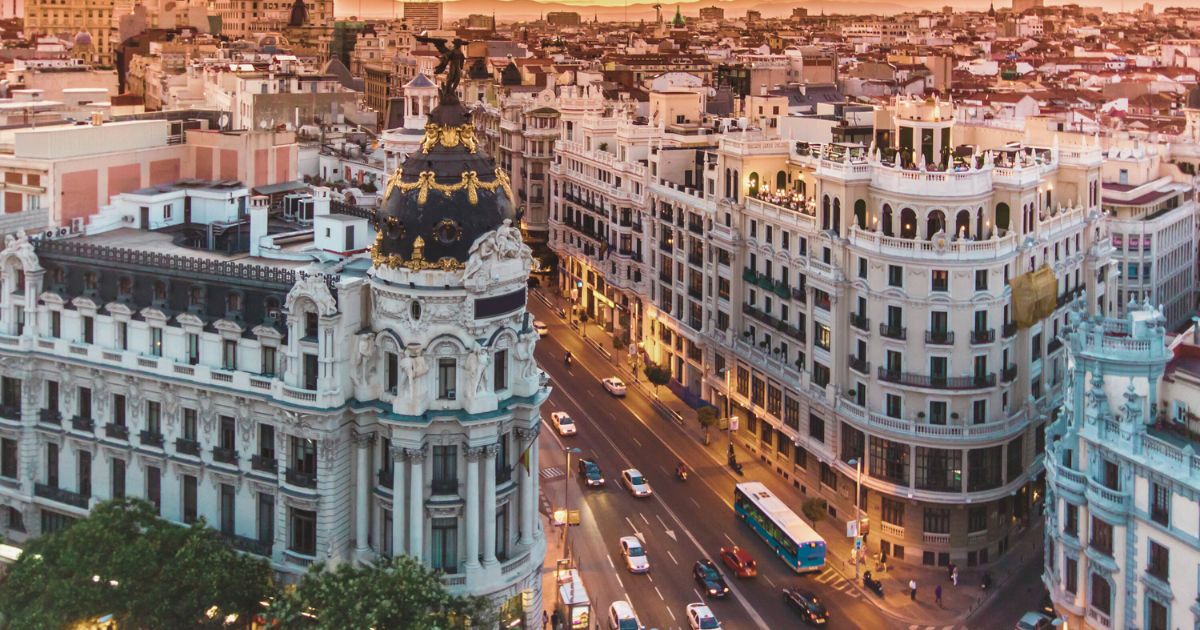The never-ending Madrid vs. Barcelona travel debate always excites visitors planning their trips to Spain. These two amazing cities, each with its own unique style and charm, offer travelers very different ways to experience Spain. While Barcelona shines with its Mediterranean beaches, playful architecture, and relaxed vibe, Madrid stands out with its grand streets, top museums, and lively city energy.
This detailed comparison will help you explore the special qualities of each city so you can decide which Spanish city fits your travel style and interests best.
Cultural experiences: history, art, and architecture
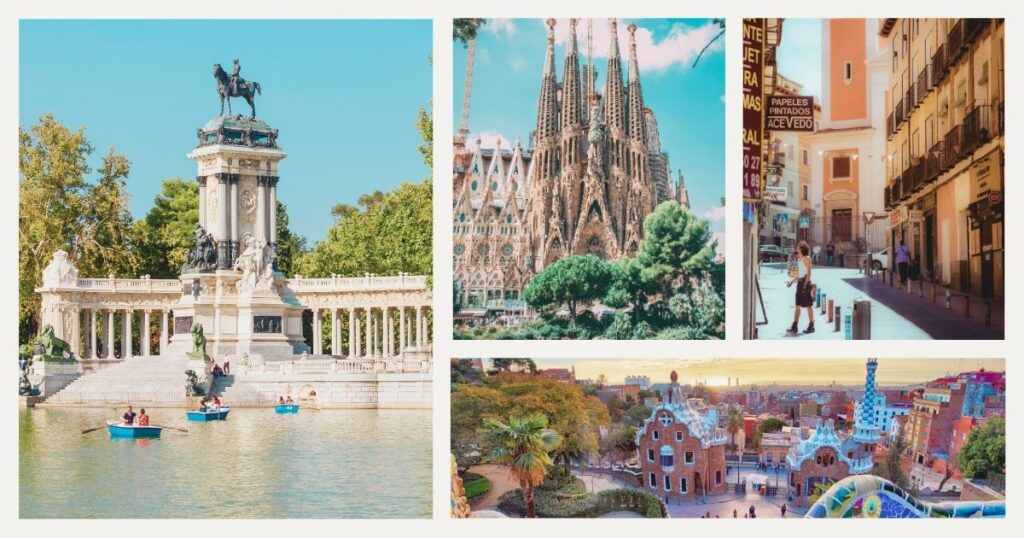
The Madrid vs. Barcelona travel comparison starts with their cultural highlights, as both cities showcase Spain’s rich history but in very different ways.
Madrid: classic elegance and traditional Spain
As the country’s capital, Madrid reflects Spain’s historic power and classic character. The city’s culture is filled with grand old buildings, royal landmarks, and some of the world’s top art collections.
Madrid’s famous “Golden Triangle of Art”—which includes the Prado, Reina Sofía, and Thyssen-Bornemisza museums—holds masterpieces by Spanish greats like Velázquez, Goya, and Picasso. The Royal Palace, Europe’s largest working royal palace, lets visitors step back into Spain’s royal history with its richly decorated rooms.
💡 Did you know? Madrid’s Prado Museum displays only about 8% of its total collection at any given time, with the remainder stored in vaults and occasionally rotated into exhibitions.
Barcelona: artistic innovation and Catalan identity
Barcelona’s cultural identity is deeply tied to Catalonia’s unique heritage and the city’s long tradition of artistic creativity. One of the clearest signs of this creative spirit is Antoni Gaudí’s imaginative architecture, which has come to symbolize Barcelona.
Gaudí’s works—including the still-unfinished Sagrada Familia basilica, the flowing shapes of Casa Batlló and Casa Milà, and the playful Park Güell—turn Barcelona into a living museum of Modernisme (Catalan Art Nouveau). Meanwhile, the Gothic Quarter keeps the city’s medieval history alive with its narrow, maze-like streets, hidden squares, and the grand Barcelona Cathedral.
🌟 Pro tip: When planning your Madrid vs Barcelona trip, remember that Barcelona’s top Gaudí sites often need advance tickets to skip long lines, especially in busy seasons.
Lifestyle and atmosphere: urban rhythms
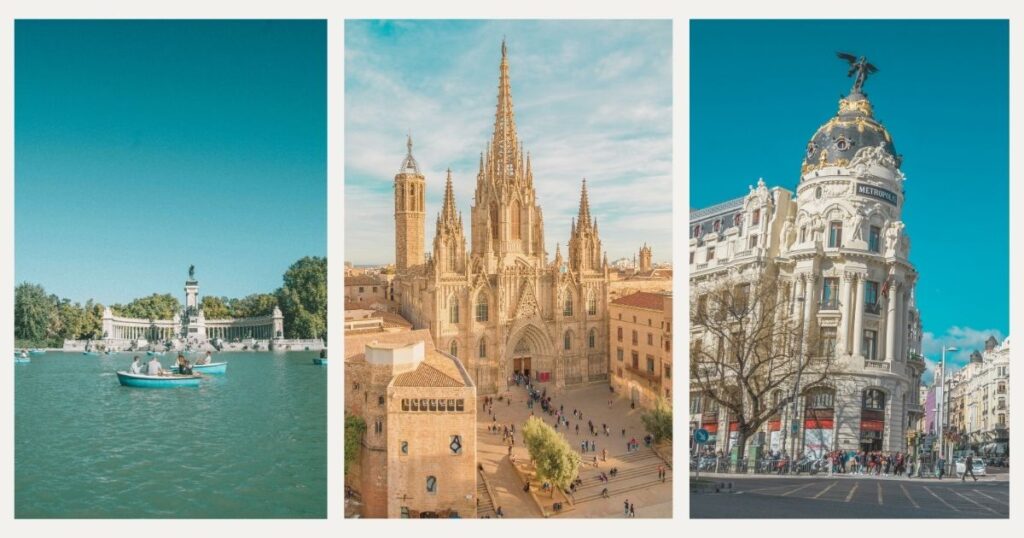
Perhaps the most significant difference in the Madrid vs Barcelona travel experience lies in the contrasting rhythms and atmospheres of these cities.
Madrid: energetic capital with a 24-hour pulse
Madrid pulses with the energy of a capital city that balances tradition and modern life. The madrileños (locals of Madrid) are known for their lively spirit and love of nightlife. The city truly wakes up after dark, with dinners often starting after 9 PM and parties going on until the early morning hours.
Despite its busy urban feel, Madrid offers plenty of green spaces. El Retiro Park is the city’s green heart, where people relax by rowing on the lake, walking through well-kept gardens, or watching spontaneous performances.
Barcelona: mediterranean lifestyle by the sea
Barcelona’s Mediterranean setting deeply influences its vibe, giving the city a more relaxed pace and an outdoor-focused lifestyle. Thanks to the nearby sea, beaches blend seamlessly into the city, and the mild climate encourages outdoor activities throughout the year.
The city strikes a balance between popular tourist spots and genuine local neighborhoods like Gràcia, Poblenou, and Sant Antoni, where daily life flows at a laid-back Mediterranean rhythm. Because Barcelona is compact, it’s easy to explore on foot, and public transport is quick and reliable for reaching farther places.
💡 Did you know? Barcelona offers the unique advantage of combining urban exploration with beach relaxation in a single day—something impossible in landlocked Madrid.
Culinary landscapes: a tale of two gastronomies
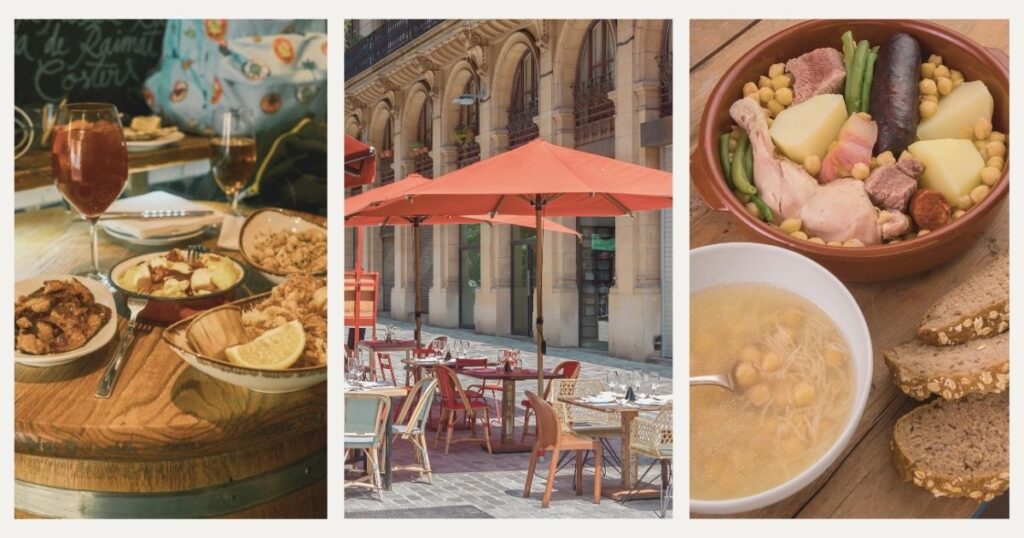
Both cities have great food, but their styles are different because of the local ingredients and traditions.
Madrid: hearty dishes and traditional flavors
Madrid’s food is heavier and uses a lot of meat since it’s far from the sea. Some typical dishes are cocido madrileño (a chickpea and meat stew), bocadillo de calamares (fried squid sandwich), and roasted meats. Madrid also offers food from all over Spain. Today, chefs in Madrid mix traditional recipes with new ideas and flavors from other countries.
Barcelona: fresh seafood flavors and Catalan creativity
Barcelona’s food uses lots of fresh ingredients from the sea and mountains, following Catalan traditions. Popular dishes include paella barceloneta (seafood paella), fideuà (noodle paella), and escudella i carn d’olla (a Catalan stew). Famous markets like La Boqueria on Las Ramblas have fresh fruits, vegetables, and seafood. Barcelona is also known for its innovative chefs, like Ferran Adrià, who changed the way people cook in Spain.
🌟 Pro tip: When planning your Madrid vs Barcelona trip, keep in mind that people in Barcelona usually eat dinner earlier, between 8:30 and 10:30 PM. In Madrid, dinner is often from 10 PM to midnight.
Practical considerations for digital nomads and travelers

Besides culture and lifestyle, practical things also matter when choosing between Madrid and Barcelona, especially for digital nomads planning longer stays.
Housing and cost of living
Madrid is usually cheaper for housing, eating out, and entertainment. You can get bigger apartments in newer buildings with better facilities for less money than in Barcelona.
In Barcelona, neighborhoods like Eixample, Gràcia, and Poblenou are popular with expats and digital nomads because they mix local life with good services. But apartments tend to be smaller and often in older buildings.
Internet and technology
Good internet is very important for remote work, so it’s worth comparing this too. Both cities have fast internet and many coworking spaces, but there are some differences.
Madrid has invested a lot in internet infrastructure, with fast connections available in most neighborhoods and homes. Barcelona was one of the first cities in Europe to attract digital nomads and has a strong community and good support services.
🌟 Pro tip: If you plan to stay in Madrid or Barcelona for a while, use Holafly’s eSIM. It gives you mobile data as soon as you arrive and acts as a backup while you set up permanent internet.
Transportation and accessibility
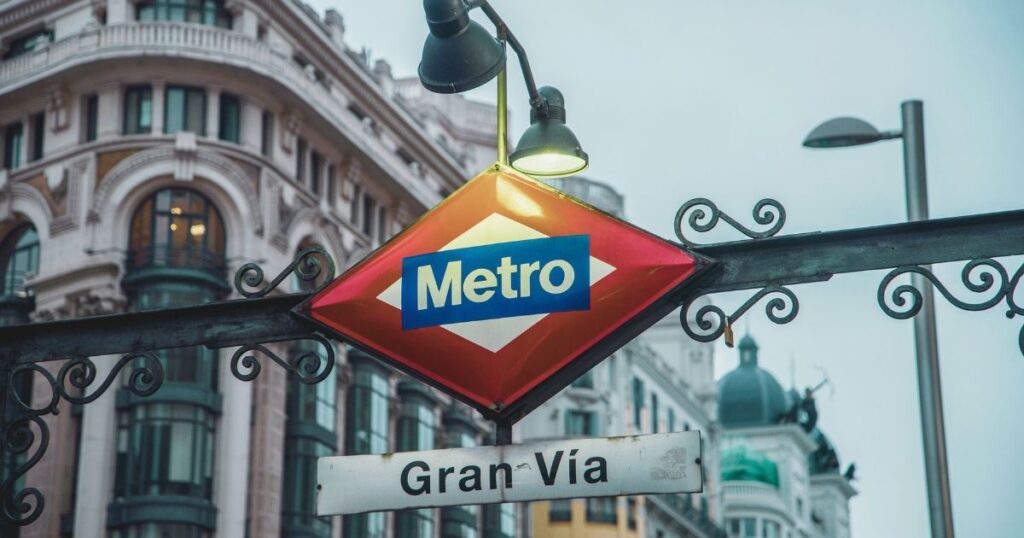
Both Madrid and Barcelona are great for getting around, but each city’s transport reflects its own layout and what travelers need.
Getting around Madrid
Madrid has one of Europe’s best and biggest metro systems, with 12 lines that cover most places travelers want to visit. The city’s grid-like street plan in the center makes it easy to find your way, even if you’re new to Madrid.
If you’re a digital nomad staying for a while, Madrid has monthly transport passes that save money, like the unlimited-use Abono card. The city’s bus network fills in where the metro doesn’t reach and even runs some routes 24 hours a day.
💡 Did you know? Madrid’s metro is the seventh-longest in the world, with over 294 kilometers of track and 302 stations—impressive for a city this size.
Navigating Barcelona
Barcelona’s more compact dimensions mean many major attractions lie within comfortable walking distance of each other, particularly in the historic center and along the waterfront promenade. The city’s comprehensive metro system, though smaller than Madrid’s, efficiently connects all key neighborhoods and sights.
A distinctive feature of Barcelona’s transportation landscape is its excellent integration of multiple modes—metro, buses, trams, and funiculars all operate under a unified ticketing system. The T-Casual ticket, which allows 10 journeys on any combination of transport modes, offers particular value for short-term visitors.
🌟 Pro tip: when comparing Madrid vs Barcelona travel options, consider that Barcelona’s more condensed layout often means less time spent on public transportation between sights, potentially allowing for more efficient sightseeing, especially on shorter visits.
The timing of your Madrid vs Barcelona travel decision significantly impacts your experience in either city, as their distinct climates create different optimal visiting seasons.
Madrid’s seasons
Madrid has a continental climate, which means hot, dry summers with temperatures often over 35°C (95°F) in July and August. Spring (April to June) and fall (September to October) are the best times to visit, with nice weather and many cultural events.
Winters can be cold, sometimes close to freezing, but snow is rare. December is special with festive lights and Christmas markets that make the city feel magical even in the chilly weather.
Barcelona’s mediterranean calendar
Because Barcelona is by the coast, its weather is milder than Madrid’s. Winters are warmer, and summers aren’t as hot. The busiest tourist season is summer (June to August), when people enjoy both the city and the beaches.
May, September, and October are great times to visit because the weather is nice, beaches are open, and there are fewer crowds. Winters are mild too, with daytime temperatures usually above 10°C (50°F).
💡 Did you know? Barcelona gets nearly 32 million visitors each year (before the pandemic), even though only about 1.6 million people live there. This puts a lot of pressure on the city’s resources.
Final thoughts: making your decision
The Madrid vs Barcelona travel debate doesn’t have one right answer—each city has its own strengths depending on what you like, how you travel, and what you want to see in Spain.
Choose Madrid if you want to experience classic Spanish culture, world-famous museums, a lively city life, and easy access to other parts of Spain. Madrid feels more like everyday Spanish life and has fewer international tourists.
Pick Barcelona if you like creative architecture, Mediterranean beaches, milder weather, and a more international, cosmopolitan vibe. Barcelona is smaller and easier to get around, making it great for shorter trips while still offering a wide range of things to do.
If you’re a digital nomad planning a longer stay, think about which city’s lifestyle, cost, and work scene suit your needs best. Many remote workers like Barcelona’s relaxed balance between work and life, while others prefer Madrid’s busy professional world and lower housing costs.
Looking to optimize your travel experience in either city? Check out Nomada’s guide to the best coworking spaces across Spain to find your ideal remote work environment.
Ready to explore these magnificent Spanish cities? Let Nomada be your guide to creating the perfect Spanish adventure, whether you choose vibrant Madrid, captivating Barcelona, or decide to experience both iconic destinations 🌍
Frequently asked questions about Madrid vs Barcelona travel
First-time visitors often find Barcelona more immediately accessible with its striking Gaudí architecture and beach proximity. However, Madrid offers a more comprehensive experience of traditional Spanish culture and history. Consider your primary interests—architectural innovation and Mediterranean ambiance (Barcelona) versus classical art and traditional Spanish urban life (Madrid).
Yes, Madrid and Barcelona are connected by high-speed AVE trains that cover the distance in approximately 2.5 hours. Many travelers successfully combine both cities in a single journey, allowing 3-4 days in each. The cities complement each other perfectly, providing a more complete Spanish experience when visited together.
Madrid generally offers better value across accommodation, dining, and entertainment categories. Barcelona’s popularity with international tourists has driven prices higher, particularly in the historic center and areas near major attractions. Budget-conscious travelers typically find their euros stretch further in Madrid, especially for accommodations and local dining experiences.
Barcelona tends to have more English speakers due to its international tourism focus and larger expatriate community. Madrid has fewer English speakers outside tourist establishments, especially among older generations. Both cities have seen improvement in English proficiency in recent years, particularly among younger residents working in hospitality and technology sectors.
Both cities offer excellent day trip possibilities. Madrid provides easy access to historic Toledo, Segovia, and Ávila—all UNESCO World Heritage sites featuring medieval architecture. Barcelona serves as a gateway to Montserrat monastery, the Salvador Dalí museum in Figueres, and Costa Brava beach towns. Your preference depends on whether you favor historical excursions (Madrid) or a mix of culture and natural scenery (Barcelona).
